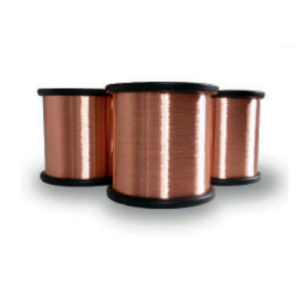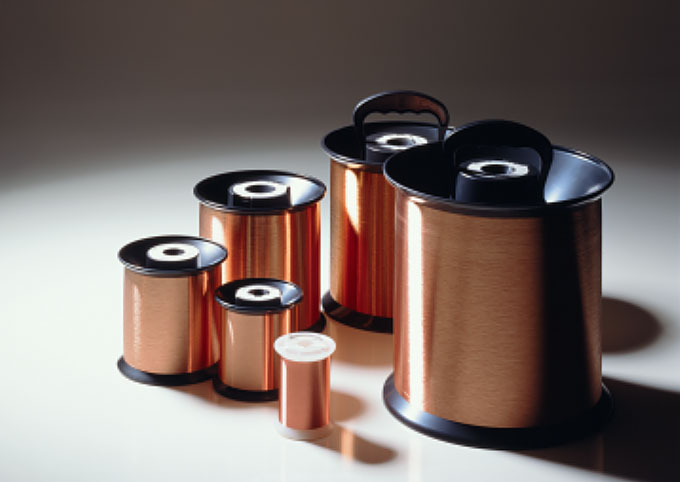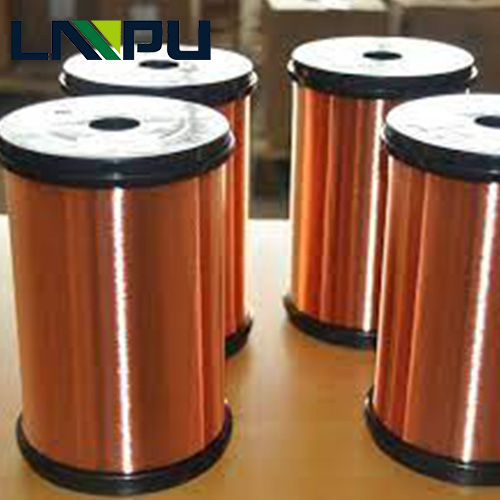Insulated Wire and Method of Producing the Same
An insulated wire which comprises an aluminum conductor, having: an adhesion layer formed by directly baking, on the aluminum conductor, varnish containing a carboxy group; an insulation layer as an outer layer of the adhesion layer; and a reinforcement insulation layer as an outer layer of the insulation layer; and a method of producing the same.
TECHNICAL FIELD
The present invention relates to an insulated wire and to a method of producing the same.
BACKGROUND ART
Inverters have become installed in many types of electrical equipments, as efficient variable-speed control units. Inverters are switched at a frequency of several of kHz to several tens of kHz, to cause a surge voltage at every pulse thereof. Inverter surge is a phenomenon in which reflection occurs at a breakpoint of impedance, for example, at a starting end, a termination end, or the like of a connected wire in the propagation system, and consequently, to apply a voltage twice as high as the inverter output voltage at the maximum. In particular, an output pulse occurred due to a high-speed switching device, such as an IGBT (insulated gate bipolar transistor), is high in steep voltage rise. Accordingly, even if a connection cable is short, the surge voltage is high, and voltage decay due to the connection cable is also low. As a result, a voltage almost twice as high as the inverter output voltage occurs.
As coils for electrical equipments, such as inverter-related equipments, for example, high-speed switching devices, inverter motors, and transformers, use is made of insulated wires, which are mainly enameled wires, as magnet wires in the coils. Further, as described above, since a voltage almost twice as high as the inverter output voltage is applied to the in inverter-related equipments. Thus, it has become required to minimize the inverter surge deterioration of the enameled wire, which is one of the materials constituting the coils of those electrical equipments.

In general, partial discharge deterioration is a phenomenon in which an electrical-insulation material undergoes, in a complicated manner, for example, molecular chain breakage deterioration caused by collision with charged particles that have been generated by partial discharge of the insulating material, sputtering deterioration, thermal fusion or thermal decomposition deterioration caused by local temperature rise, and chemical deterioration caused by ozone generated due to discharge. For any of those, reduction in thickness of the electrical-insulation materials may be observed, which have been deteriorated as a result of the partial discharge.
It is believed that inverter surge deterioration of an insulated wire also proceeds by the same mechanism as in the case of general partial discharge deterioration. That is, inverter surge deterioration of an enameled layer is a phenomenon in which partial discharge occurs in the insulated wire due to the surge voltage with a high peak value, which is occurred at the inverter, and the coating of the insulated wire causes partial discharge deterioration as a result of the partial discharge, resulting in that the inverter surge deterioration of an enameled layer of the coating of the insulated wire is high-frequency partial discharge deterioration.
Such a deterioration of the enameled layer of the insulated wire can be prevented by the insulated wire having a high partial discharge inception voltage, and a method of using a resin having low relative permittivity in the enameled layer, and/or a method of increasing a thickness of the enameled layer, are considered.
However, in the former method, if other characteristics (heat resistance, solvent resistance, flexibility, and the like) required for the enameled layer are taken into consideration, it is difficult to select the resin having a particularly low in relative permittivity.
Moreover, in order to satisfy electrical properties, such as dielectric breakdown voltage and partial discharge inception voltage in the latter method, 60 μm or more is empirically required as the thickness of the enameled layer.

However, if a wire is passed through a high-temperature baking furnace a plurality of times in a production process in order to increase a thickness of an enameled layer composed of a thermosetting resin, a copper oxide coating grows on a surface of copper being a conductor, and adhesion force between the conductor and the enameled layer is lowered. As a result, there has existed a problem in which workability, such as flexibility, is significantly lowered.
Moreover, if the thickness to be applied in one-time baking is increased in order to reduce the number of times passing through the baking furnace, there has existed a disadvantage in which a solvent in varnish is not wholly evaporated and remains as gas bubbles in the enameled layer.
On the other hand, weight reduction is required for a motor, and development has been advanced on significant weight reduction of the coils by using an aluminum conductor. Not only the weight can be reduced by use of aluminum, but also ease of bending, namely flexibility being important for a winding wire for coils can also be improved.
Moreover, a passive state is formed on a surface of the aluminum conductor. Thus, lowering in the adhesion force between the conductor and the enameled layer as caused by growth of oxide coating, which has become the problem in the cupper conductor, can be prevented, and damage on an electrical wire coating in a coil working step, and lowering in electrical insulation performance can be prevented. In particular, the insulated wire having high mechanical strength, such as abrasion resistance, can be produced.
Where, it is understood that tensile stress applied to the conductor is increased by increasing the number of times of baking in baking of the enameled wire. Moreover, it is also known that physical strength of the conductor is significantly lowered by increase of a received heat quantity when aluminum is used for the conductor. Owing to these two phenomena, there has existed a problem in which reliability as the winding wire is reduced, such as lowering in accuracy of a conductor diameter or rupture strength (breaking strength) of the conductor by increasing the number of times of baking, in the case of the aluminum conductor enameled wire.
Hitherto, attempts have been made on improving characteristics, such as high heat resistance and high abrasion resistance, by a newly provided covering resin layer, in addition to enhance the partial discharge inception voltage by providing a covering resin outside the enameled wire. Proposals have been made on providing an extrusion covering layer on an enameled layer in, for example, Patent Literatures 1, 2, and the like. On the other hand, it is understood that, when extrusion covering is performed on the enameled wire of the Al conductor, adhesion force between the aluminum conductor and the enameled layer is readily lowered because a temperature of an extruded resin is high. However, no studies have been made on the adhesion force between the conductor and the enameled layer in the arts proposed in Patent Literatures 1 and 2. When coil winding on the motor or the transformer is performed in a state in which the adhesion force between the conductor and the enameled layer is low, damage is readily caused on the electrical wire coating in the coil working step, to cause a problem in which the electrical insulation performance is lowered and the reliability of a product is lowered.

It has become demanded to further improve various performances, such as heat resistance, mechanical properties, chemical properties, electrical properties, and reliability, in the electrical equipments developed in recent years, as compared to the conventional electrical equipments. Under the situations, excellent abrasion resistance, thermal aging resistance, and solvent resistance have become required for insulated wires, such as enameled wires, that are used as magnet wires for electrical equipments for aerospace use, electrical equipments for aircraft, electrical equipments for nuclear power, electrical equipments for energy, and electrical equipments for automobiles. For example, in recent electrical equipments, a capability of maintaining excellent thermal aging resistance for a further longer period of time is required in several cases.
Further, electrical equipments, which are represented by motors or transformers, have recently advanced in size reduction and performance improvement, and it becomes found that, in many applications, insulated wires to be used are pushed into a quite narrow space to pack. Specifically, it is not an exaggeration to say that the performance of a rotary electric machine, such as a motor, depends on how many electrical wires can be placed and packed in a stator slot.
As a result, as a means for increasing the ratio of the cross-sectional area of the conductor to the cross-sectional area of the stator slot (hereinafter, referred to a stacking factor or a space factor), it has been lately attempted to use a rectangular wire in which the conductor has a shape similar to a quadrilateral (square or rectangle). Use of a rectangular wire exhibits a dramatic effect in increasing the stacking factor. However, there are known that it is difficult to uniformly apply an insulation coating on a rectangular conductor, and that it is particularly difficult to control the thickness of the insulation coating in an insulated wire having a small cross-sectional area.

From:Application US15/368,235 events
Our Products
Customer Industries
